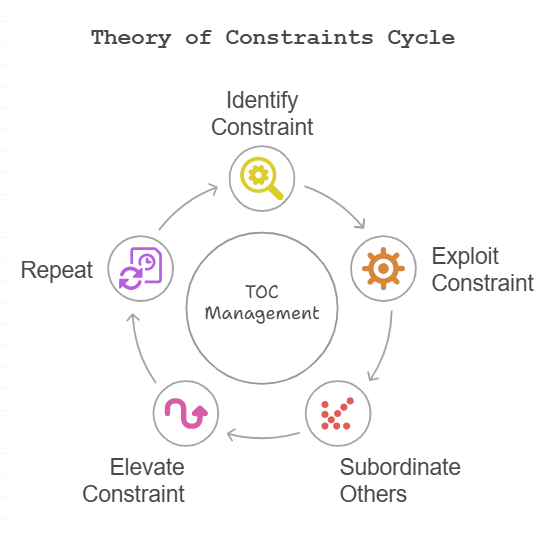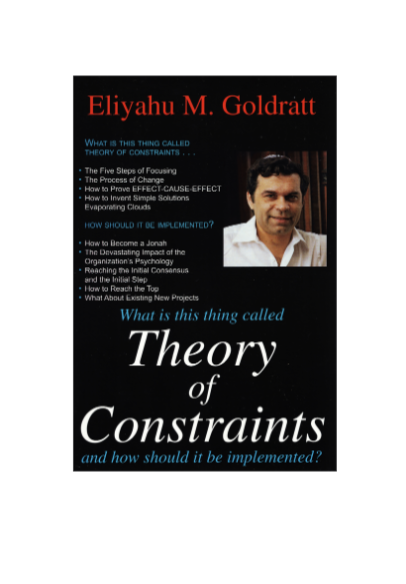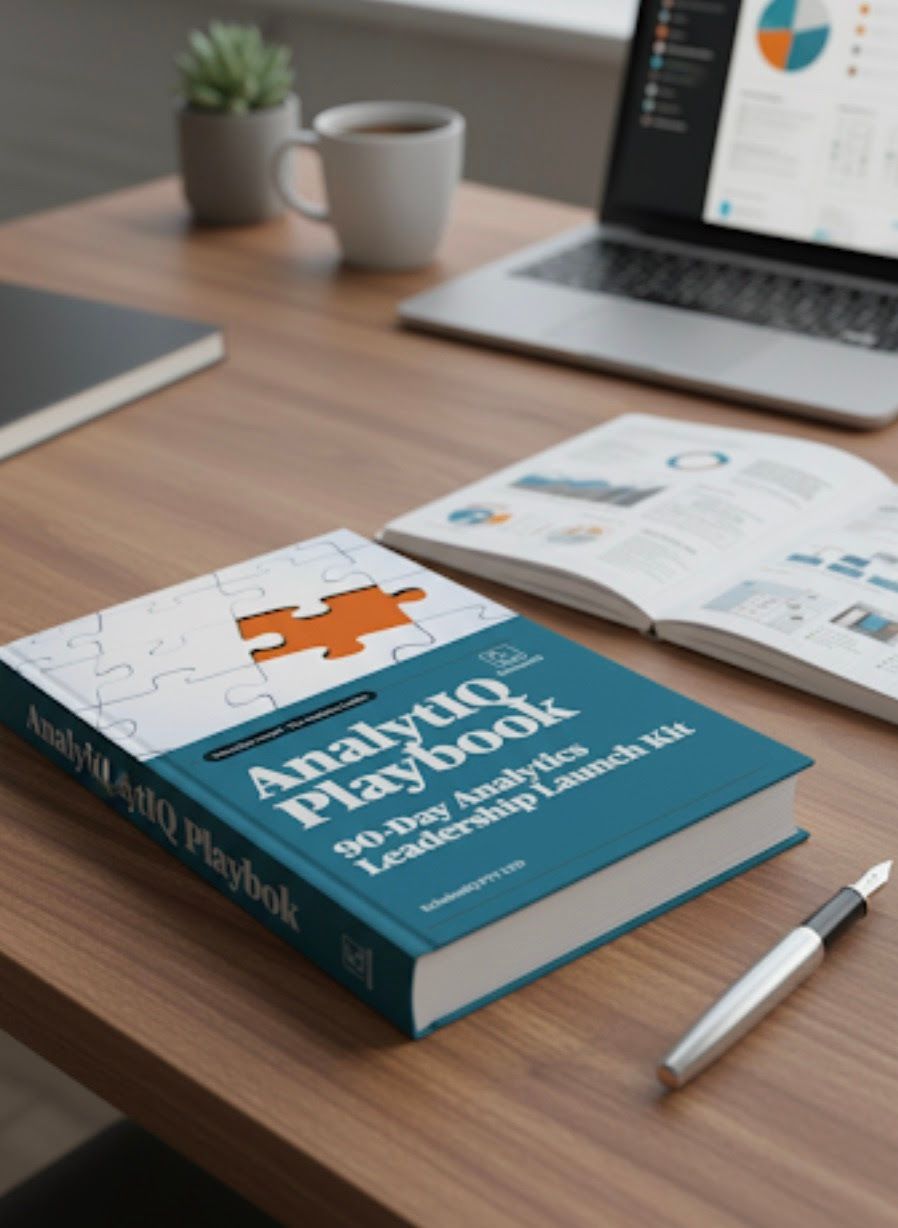- The Analytics Ladder
- Posts
- Your Dashboard Isn’t Broken. Your Focus Is.
Your Dashboard Isn’t Broken. Your Focus Is.
The midweek playbook for turning book smarts into career-making influence.

Every analytics leader knows the pain.
We hoist up dashboards, craft endless insights and pray someone else will make it count.
But, what we pretend doesnt happen: most of those eureka moments fizzle on the conference room screen, never actually shifting how work gets done or what turns the dial for the business.
This week, let’s get hands-on with Eliyahu Goldratt’s Theory of Constraints.
This is not just for analytics leaders; it’s for those ready to grab the steering wheel and drive real, gritty change, fast.
The Theory of Constraints Approach
Most teams get nowhere fast because they try to fix everything instead of the one thing that really matters. The Theory of Constraints says your job is to hunt down the single point that’s slowing things to a crawl, then go all in.
No distractions, no busywork, just relentless focus on the real blocker.
The Big Idea
Every operation has at least one constraint, that bottleneck that calls the shots on how much gets done. Trying to boost non-constraints is just shuffling papers.
You want real impact? Find the constraint, focus all effort there, and watch your whole system unlock.
How To Use This in Your Analytics Work
Map your workflow, pour effort into elevating the constraint, align the team to support it, and get everyone in the habit of busting new bottlenecks as they emerge. True results come when you relentlessly clear the chokepoints, not when you spread effort thin.
Lets go!
How to spot the weakest link in your workflow (and fix it before it strangles results).
Forget the filler. "Theory of Constraints" by Eliyahu Goldratt is the only business book that feels like a story but actually changes how you work.
No jargon, just real lessons from a plant manager on the brink, showing how every battle with bottlenecks matters.
You’ll finish it, remember it, and use it.
Goldratt’s real punch is in how he refocuses your energy. Instead of obsessing over every metric or process, he insists that real change comes from zeroing in on the weakest link, the bottleneck that limits everything else.
This isn’t theoretical, it’s how teams move from busy to game-changing, and why Goldratt’s lessons still set the standard for operational excellence years after first hitting the shelves.
Whether wrangling data or steering a business unit, the lessons from Goldratt stick because they’re simple, practical, and powerful. If you’re ready to see real progress, put your focus where it counts, the bottleneck, and witness how quickly everything else can change.
This is the kind of thinking that separates those who make noise from those who move the needle.
Your Playbook: The Metrics Tree
First off, ditch the data fog.
Build a metrics tree that describes your problem, top to bottom.
Start with the big kahuna goal, say, booking revenue. Then break it into each conversion stage along the pipeline: Show Up, Make Offer, Close Sale, Revenue. (Consulting firms would probably do this via a MECE diagram)
Track every stage, every week. You’ll start to see where the whole operation actually leaks or stacks up. Think of this as turning your business problem into a well-lit street, no shadows for mediocrity to hide.

Identify the Constraint
Goldratt’s Theory of Constraints reveals a little something about business: making 100 small improvements doesn’t move the needle if one link in the chain is massively broken.
His method is to benchmark every metrics tree stage, either against internal targets, industry standards, or historical performance. And then identify the constraint, the stage whose performance most restricts overall throughput.
For example, a sales function where show rates or close rates are massively off target becomes ground zero. Fixing anything else offers marginal or no improvement until the bottleneck is resolved.
Exploit the Constraint
Finding the constraint isn't guesswork.
Goldratt sets clear targets for each metric; these benchmarks might come from experimentation, industry standards, or past results.
Variance analysis, such as using control charts or year-over-year comparisons, shines a spotlight on outliers. The bottleneck typically sits upstream, where a constraint in lead generation or sales management can cascade down and choke results everywhere else.
Identifying it means analytics leaders can stop wasting cycles on optimising sub-processes and focus efforts for maximum leverage.
Subordinate Everything Else
With the constraint identified, Goldratt's framework shifts into rapid animation. The next step is aligning all other processes to support the constraint, ensuring that your resources and teams are reinforcing the area with the greatest potential for impact, rather than pushing work somewhere that cannot be processed efficiently.
Elevate the Constraint
Once you know where the choke point lives and everything is aligned, it’s time to invest and innovate. Change incentives, upgrade technology, add capacity, or redesign the workflow to break through the bottleneck.
This is how compounding gains are made quickly, driving measurable improvement versus incremental tinkering.
Repeat the Process
When the constraint has been resolved, circle back and hunt for the next one. This systematic approach keeps momentum rolling and operational excellence from turning stagnant.
Start your journey towards a data leader on the right foot with our latest subscriber reward, The AnalytIQ Playbook: 90 Day Analytics Leadership Launch Kit.
A concise guide packed with actionable strategies to set you up for success.
Download it today and tell us what you think as you put its insights into practice!
What To Do Next
Map your whole problem space with a metrics tree. Visibility is everything.
Set brutal benchmarks. Only numbers that move the needle count.
Pick your single biggest bottleneck. Forget the rest for now.
Launch fast experiments, iterate weekly, not yearly.
When you fix it, move down the tree and repeat. That’s how empires grow, systematically, not by chance.
Work the five focusing steps from TOC. The other steps can wait.
Wrapping It Up & Your Next Move
Goldratt’s Theory of Constraints turns analytics from a rear-view mirror into rocket fuel.
If you want to be more than a spreadsheet jockey, go find your biggest business blocker, attack it, and celebrate compounding wins. Take the reins this week, don’t just report, transform.
Map your bottlenecks, run a test, and let the group know what moved. Let’s make analytics the engine that powers our results, one constraint at a time.
Ready to turn noise into results?
Take one bold step this week. pick your single biggest constraint, attack it head-on, and watch how quickly your numbers start telling a new story.
Best,
Jazzy.
Know one teammate who’s drowning in rework or worried AI is eating their job? Forward this to them—you’ll help them climb and unlock the new referral reward: the Delta Teams Playbook, your crisis-mode toolkit when the wheels come off.
Not on The Analytics Ladder yet? You’re missing the brand-new 90-Day Analytics Leadership Action Kit. It’s free the moment you join—your step-by-step playbook to win trust in 14 days, build a system by day 45, and prove dollar impact by day 90.
Disclaimer: Some of the books, articles and excerpts referenced in this issue may be copyrighted material. They are included here strictly for review, commentary and educational purposes. We believe this constitutes fair use (or “fair dealing” in some jurisdictions) under applicable copyright laws. If you wish to use any copyrighted material from this newsletter for purposes beyond your personal use, please obtain permission from the copyright owner.
The information in this newsletter is provided for general educational purposes only. It does not constitute professional, financial, or legal advice. You use this material entirely at your own risk. No guarantees, warranties, or representations are made about accuracy, completeness, or fitness for purpose. Always observe all laws, statutory obligations, and regulatory requirements in your jurisdiction. Neither the author nor EchelonIQ Pty Ltd accepts any liability for loss, damage, or consequences arising from reliance on this content.
Visit our website to see who we are, what we do. | |
Our blog covering the big issues in deploying analytics at scale in enterprises. |

